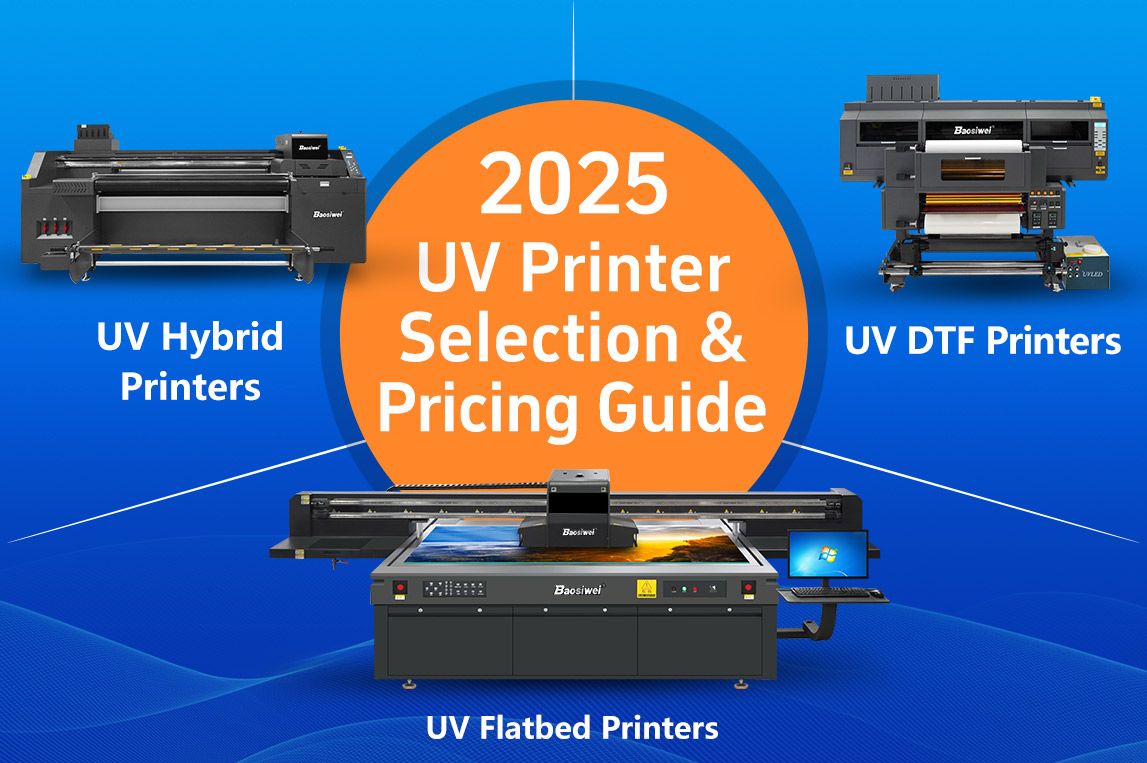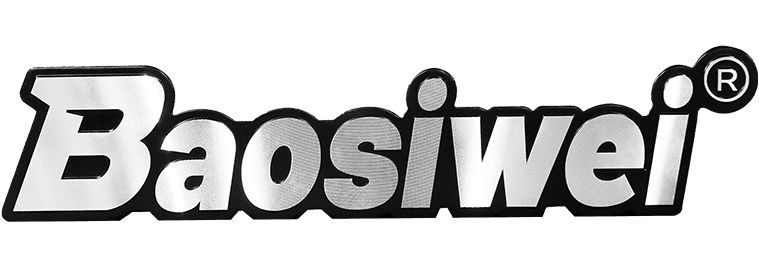
2025 UV Printer Selection & Pricing Guide
Introduction
In 2025, if you are looking for digital printing solutions, one unavoidable question is: how much does a UV printer cost?
The answer is not simple, as UV printer prices vary widely — from desktop entry-level models (starting around ¥10,000) to large industrial UV flatbed and high-tech models (up to ¥250,000).
With nearly 30 years of digital printing experience, Baosiwei has provided a full range of UV printing solutions to thousands of enterprises — from small startup workshops to large-scale manufacturing mega-factories. We fully understand that customers of different scales have completely different concerns regarding price and functionality.
To help you quickly understand the market, judge price ranges, and select the most suitable model in 2025, we have compiled a super-detailed industry-level UV printer buying guide. This article not only covers price ranges but also provides in-depth explanations of core components, application scenarios, buying considerations, and Baosiwei’s industry solutions, so you can make decisions with confidence and understand how to achieve long-term ROI through the right choices.
Table of Contents
- What is a UV Printer? Why Is It Becoming More Important in 2025?
- Pre-Purchase Analysis — Questions You Must Answer Before Buying
- UV Printer Types Explained
- 2025 UV Printer Price Ranges
- Consumables & Selection Advice
- Conclusion: How to Choose the Right UV Printer for Your Business
What Is a UV Printer? Why Is It Becoming More Important in 2025?
Before diving into specific price ranges and selection, it’s essential to understand the core principles and value of UV printers.
How UV Printers Work
UV printers are non-contact digital inkjet printing devices. Using dedicated control software, patterns are directly sprayed onto the substrate surface, while UV lamps instantly cure the ink to make it firmly adhere to the material.
The essential differences from traditional printing include:
- No plates needed: Saves time and cost, perfect for short runs, small batches, and diversified production;
- Instant curing: Prints can immediately proceed to post-processing or delivery without waiting for ink to dry;
- Wide material compatibility: Almost any flat or curved material can be printed, including wood, metal, glass, ceramics, leather, plastic, acrylic, paper, etc.;
- Special effects output: Supports white ink, UV coating, embossing textures, metallic effects, etc., giving products higher added value.
Technical Advantages of UV Printers
By 2025, UV printers are no longer "cutting-edge experiments" but mainstream tools for large-scale industrial production and personalized customization. Core advantages include:
- High-precision printing: Printheads can control micron-level droplets, achieving photo-quality imaging;
- True-to-life color reproduction: Coupled with color management systems (CMS) to achieve standardized colors across devices;
- High-efficiency production: Large flatbed UV printers can produce over 100 m² per hour, suitable for industrial-level output;
- Environmentally friendly: UV inks have low VOC emissions, and some models are SGS, RoHS, OEKO-TEX certified;
- Flexible manufacturing: Ideal for "small batch, multi-variant, personalized" orders.
Why UV Printers Are Increasingly Important in 2025
- Cross-industry adoption: Electronics housings, advertising displays, home building materials, packaging, industrial labels, automotive interiors, etc., are increasingly using UV printing;
- E-commerce & personalization trends: Consumer demand for "customized" and "one-piece" printing has surged, perfectly meeting market needs;
- Green policies: Markets in Europe, the U.S., and Southeast Asia gradually phase out high-pollution printing methods, promoting UV printing;
- Industry 4.0 & automated production: More enterprises integrate UV printers into intelligent production lines with automated feeding, vision alignment, and fully unmanned production;
- Cost & efficiency advantages: Compared to traditional screen or pad printing, UV printing eliminates plates and enables instant curing, significantly reducing trial production and multi-product development costs.
By 2025, UV printers are no longer tools limited to one industry—they are versatile production equipment spanning B2B and B2C markets. From startups to large factories, UV printing provides solutions at all levels.
Pre-Purchase Analysis — Questions You Must Answer Before Buying
No one wants to waste money, especially on a device investment like a UV printer. Good decisions start with clarifying market and business needs. This is the first step in the selection process and prevents purchasing the wrong equipment or affecting ROI.
Before asking "how much," answer the following questions:
1.1 What Products Are UV Printers Mainly Used For?
Product material and shape basically determine the type of UV printer you need:
- UV Flatbed Printers — best for hard materials like wood, glass, acrylic, tiles, metal sheets;
- UV Hybrid / Conveyor Printers (Roll-to-Roll) — often used for soft films, advertising materials, fabrics;
- UV DTF — best for brand customization, packaging, promotional gifts.
If you plan to cover multiple material types, equipment compatibility and expandability must be a key consideration.
1.2 How Large Is the Market Demand?
Production capacity requirements directly determine whether industrial-grade models are needed. Tens of orders per month vs. hundreds of m² daily are completely different configurations.
- Small orders → entry-level or mid-range printers are sufficient;
- Long-term, high-intensity production → high-speed, stable industrial equipment is required.
1.3 Are There Significant Peak and Off Seasons?
Many industries have seasonal fluctuations, e.g., holiday gifts, back-to-school ads, home renovation peaks.
- If peak season orders are 3–5× off-season, reserve capacity to avoid delivery delays;
- Some companies address seasonal spikes by upgrading models or running multiple machines in parallel.
1.4 Are There Special Craft or Function Requirements?
Examples:
- Do you need 3D embossing, transparent varnish, hot stamping, or special textures?
- Do patterns need to be waterproof, sun-resistant, or heat-resistant?
- Do you need one-time printing on large surfaces?
These directly affect ink selection (soft, hard, eco-friendly), curing method, and whether pre-coating or pre-treatment is required.
1.5 Do You Often Have Urgent Orders?
If clients frequently require "next-day delivery" or "within 24 hours":
- High equipment availability (stable, no downtime);
- Fast printing speed, instant curing;
- Optional spare printheads or backup machine for redundancy.
1.6 Space and Post-Processing Conditions
Often overlooked:
- Large industrial flatbeds need three-phase power, sufficient ventilation, and space for material loading/unloading;
- If factory doors/windows are too small, machines may not fit;
- Consider temperature, floor load, and post-processing requirements such as drying or lamination.
1.7 Investment Strategy: One-Time Purchase or Phased?
Some businesses start with small devices to test the market, then upgrade; Others invest in industrial machines upfront to handle large orders.
This depends on your 12–24 month business growth forecast. Clear order channels and market plans often justify large equipment for faster ROI.
Tip: For a one-on-one analysis, provide 3 typical SKUs (or commonly printed materials/sizes/monthly output). We can give customized recommendations and ROI calculations.
When evaluating a UV printer, it’s essential to consider not only performance parameters such as speed, resolution, and print size, but also the core components including the control board, printhead, software, and color management.
For a full breakdown of testing methods and component analysis, see our complete guide:UV Printer Performance Parameters & Core Components Explained
UV Printer Types Explained
Once you know "what to print" and "how much," narrow down your choices by printer type.
UV Flatbed Printer
Core Function: Designed for flat materials. Material lies flat, printhead moves over it, prints UV-curable ink, instantly cured by UV lamps.
Ideal Scenarios: Small batches, detailed patterns, thickness up to several cm (acrylic, wood, metal, tiles, phone cases, etc.).
Advantages: High precision, can do high relief, visual positioning, 3D textures; suitable for high-value products.
Limitations: Not suitable for continuous roll printing; efficiency limited for large formats or high volume; slower than screen printing.
Application Example: Gift studios printing phone cases, wooden badges, ceramic plates.
UV Hybrid Printer
Core Function: Primarily prints roll materials but can also handle some flat materials via conveyor belt.
Ideal Scenarios: Advertising factories needing PVC soft film, car decals, acrylic signs.
Advantages: Continuous operation, high speed, broader material compatibility, easier feeding, minimal waste.
Limitations: Mainly roll material-oriented; complex, higher cost, maintenance-intensive.
Application Example: Ad factory handling both signboards and packaging samples.
UV DTF Printer
Core Function: Prints design on transfer film (AB film) then transfers to the target object.
Ideal Scenarios: Brand promotion, packaging, gift customization.
Advantages: Highly adaptable, single print, no plates, instant output.
Limitations: Poor adhesion on rough surfaces.
Examples: Logos on wine boxes, cups, tea canisters, crafts.
2025 UV Printer Price Ranges
Entry-Level UV Printers (¥10,000 – ¥35,000)
Features & Applications: Small startups, e-commerce, gift workshops, small stores; prints phone cases, keychains, ceramics, small cultural gifts; limited print area, slower speed.
Advantages: Affordable, low entry barrier, easy operation, compact.
Limitations: Limited print area, low output, basic features (e.g., embossing, UV coating) restricted.
Baosiwei Advantages: Stable, reliable; supports multiple materials; high cost-performance.
Reference Models: Baosiwei A3 UV flatbed printer, Baosiwei A3 UV DTF Printer (JW-302).
Mid-Range UV Printers (¥50,000 – ¥100,000)
Features & Applications: Stable mid-sized factories, advertising sign companies, medium-large enterprises; prints acrylic, glass, wood, advertising boards, brand logos; supports larger sizes and higher productivity.
Advantages: Larger print area, higher speed and precision, wider material support.
Limitations: Mid-range price, requires sufficient order volume, more space, professional operator training.
Baosiwei Advantages: Flatbed + crystal label models for hard and flexible materials; integrated color management; suitable for mid-high capacity.
Reference Models: JW-6090 UV flatbed printer, JW-604 crystal label printer, JW-604H hot stamping crystal label printer.
Industrial UV Printers (¥120,000 – ¥250,000)
Features & Applications: High-capacity, continuous production; prints large signs, leather, custom furniture, mats, etc.
Advantages: Industrial frame, advanced ink system, precise color, supports large/complex materials.
Limitations: High upfront cost, professional operation and maintenance, large footprint.
Baosiwei Advantages: Large flatbed + roll hybrid; advanced color management; full after-sales network with “One-Click Repair”; industrial reliability, high ROI.
Reference Models: JW-1612 visual positioning UV flatbed printer, JW-2513 UV flatbed printer, JW-1908 UV hybrid printer.
Consumables & Selection Advice
Consumables directly affect print quality, stability, and long-term cost. Proper selection and maintenance are key to ROI.
UV Ink
Overview: Cures quickly under UV light, widely used in advertising, decoration, 3C products, signage, faux painting.
Types:
- Neutral: Multi-purpose, good adhesion, scratch-resistant; acrylic, PS, PVC foam, KT board; moderate hardness.
- Hard: Strong adhesion, surface dry, high hardness, scratch-resistant; tiles, metal, wood, hard plastic, acrylic, glass.
- Soft: Flexible, stretchable; suitable for flexible materials like banners, soft film, leather, wallpaper, car decals, TPU/PVC, canvas.
Selection Tips: Compatibility with printheads, wide gamut and stability, adhesion & scratch resistance, environmental certification (SGS, OEKO-TEX, RoHS).
Verification: Sample printing, adhesion/scratch tests, shelf-life and storage checks, cleaning fluid compatibility, maintenance cost evaluation.
UV DTF AB Film
Workflow: Print on A film, cover with B film, transfer to target object, remove films.
Key Parameters: Width (300mm/600mm), ink absorption, adhesion/peel strength.
Selection/Testing Tips: Ensure color accuracy, edge clarity, adhesion; perform weathering & abrasion tests; verify film thickness & roll stability.
Other Consumables & Spare Parts
Cleaning fluid, spare printheads, ink tubes/capsules/pads, coating liquids, pre/post-treatment materials.
Procurement Tip: Establish 3–6 months’ inventory of key consumables and spares post-purchase.
Conclusion — How to Choose the Right UV Printer for Your Business
By 2025, UV printers are core production tools across industries.
Selection Summary:
- Clarify needs: What to print? Daily output? Special effects?
- Compare real capacity: Request production-mode tests with typical products.
- Focus on color & consumables: Certified suppliers, stable supply.
- Evaluate after-sales & spares: Keep 3–6 months consumables, 1–2 spare printheads.
- Investment strategy: Stepwise or one-time based on 12–24 month growth forecast.
3–5 Year Trends: High-precision, automation with ERP/MES, environmentally certified inks for global markets.
Contact & Next Steps
Provide 3 typical SKUs (material/size/monthly output) to receive:
- Recommended digital printer models;
- Sample printing plan & quotation;
- Visit scheduling.
Click connect us to fill out the form. Baosiwei business consultants will contact you to develop a sample testing plan.
